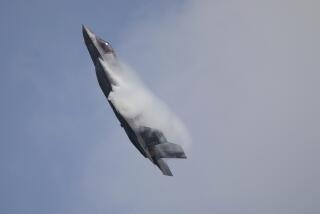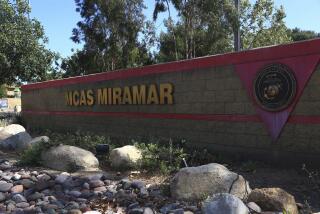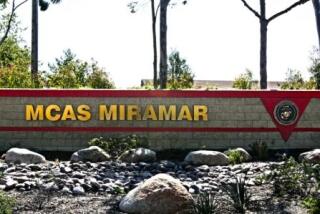Pilot of Navy Jet Is Ready to Take to the Air Again
- Share via
Cmdr. David Strong, the 36-year-old fighter pilot who bailed out of a jet moments before it exploded in a parking lot Monday morning, shrugged off the incident with calm self-assurance Monday night and said he’ll be back in an airplane as soon as the Navy clears him to fly.
“I’m fine. Physically and mentally, I’m fine. I did everything I could with the airplane and it worked out pretty well,” said Strong.
A Navy reservist with 14 years and 2,500 hours of flying experience said, “You take an airplane flying and you plan on landing it, but you don’t plan on walking away from it in a ball of flames.”
This “Right Stuff” kind of pilot with a firm jaw and perfect haircut did not expect to have any problem getting to sleep last night.
“I don’t see any reason why I should,” Strong said.
Strong, of Millersville, Md., said this is the third crash he has walked away from and he believes it is training rather than luck that has allowed him to do so.
He declined to comment on the other two crashes except to say that one was a civilian flight and the other military.
“If they clear me tomorrow, I’ll be in an airplane tomorrow,” he said.
During an evening press conference at Miramar Naval Air Station, Strong sat comfortably back in his chair and told of the events leading to the crash.
He took off from Miramar Naval Air Station at 9:10 a.m. on what was to be a routine 2-hour training mission, flying in low-level, high-speed formation with another jet to test reconnaissance equipment.
Several minutes after takeoff, Strong said, there was an explosion in the back of the plane.
“I felt it and heard it and a light in the cockpit said there was a fire,” he said. The engine died and the jet lost its electrical power.
Strong said he tried to restart the engine with a device similar to an electric pilot light on a gas range, while he searched the ground for a clear area.
“I could hear it in my headphones, but it wouldn’t start,” Strong said.
He tried an alternate electrical system, pulling a lever, throwing two switches and pushing yet another button. Meanwhile, he spoke into his dead headset in hope the pilot in the other plane could hear him.
“I told him I was headed for the beach,” Strong said. “Then I transmitted that I wasn’t going to make it.”
Fifty seconds had passed since the explosion. Strong had traveled four miles. His speed dropped from about 320 knots an hour to less than 200, and his altitude dropped from about 1,000 feet to 250.
When the plane rolled uncontrollably to the right, Strong ejected.
“I landed in the street,” he said coolly. “I got out of my parachute and asked if fire trucks had been called yet . . . I assisted the pumper in getting hoses out and fighting the fire.”
Strong credits the fact that no one was killed in the crash to the aircraft, which he said remains stable at low speeds, and to his experience. He stayed with the jet to a dangerously low altitude and aimed it toward the mountains.
“Anything below 1000 feet and 250 knots, you’re supposed to eject. I stayed with the airplane because of the congestion in the area, the proximity of the buildings, in an attempt to avoid any kind of injury wherever possible,” he said.
Airplanes are safer than cars, Strong said, adding, “Accidents happen.”
More to Read
Sign up for Essential California
The most important California stories and recommendations in your inbox every morning.
You may occasionally receive promotional content from the Los Angeles Times.













